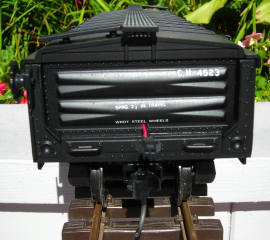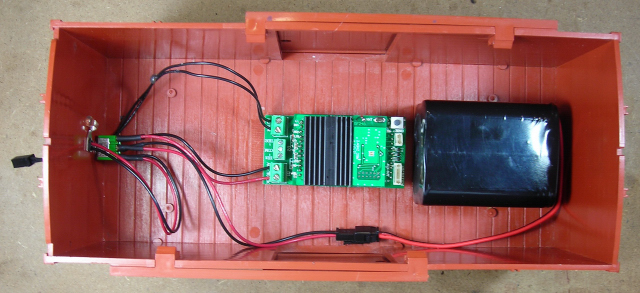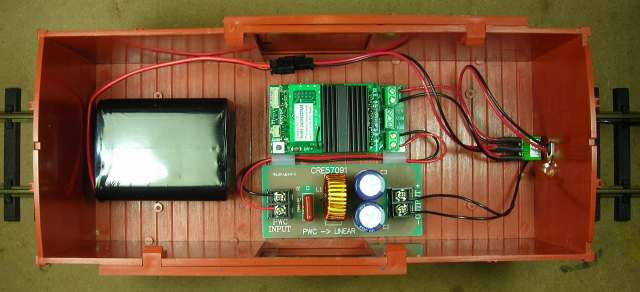A power and control car contains a battery and a radio control receiver. When plugged into the back of an Aristo-Craft Plug and Play locomotive with the power switch set to battery power, the car can battery power and radio control it. It can also battery power and radio control other locomotives that have an MU connector added and the track power wires disconnected.
The basic power car pictured uses an Aristo-Craft, lithium-ion battery and the circuit board from a 27 MHz, Trackside Train Engineer (TE) receiver. When released in 1995, the TE was designed to control an entire garden railway, but a member of our group quickly realized the potential of using it for on-board radio control.
Although other types of batteries can be used, the lithium-ion pack is small, light, provides long run times, and holds its charge during winter storage. It can be unplugged and removed to be recharged, or replaced with another battery to extend run times.
As 27 MHz Trackside TE has its own power switch and fuse, wiring the power car shown only requires a 2-wire connector set. One half is used to connect the battery to the input wires of the receiver, and the other half is the car’s MU connector attached to the output terminals. The connector sets are available from All Electronics under part number CON-240. OVGRS members only can purchase them by contacting Paul Norton.
Steam engine tenders, diesel B-units, and other freight cars can be used for a power car; but the cheapest and most practical is the covered gondola. Removing the snap on cover allows easy access to program the receiver, charge the battery or replace it with another for extended run times. Replacing the cover hides the components and protects them from the elements. The ends of the gondola can also be folded down inside the car should extra cooling be required for the receiver.
Aristo-Craft now offers an on-board and trackside version of their 2.4 GHz Revolution Train Engineer receiver. Although these new receivers have very short antennas to make installation much easier, they have much better radio range than their predecessors. They also come with the ability to adjust the running characteristics of the locomotive on the track to suit the individual owner and locomotive.
The installation of an on-board Revolution receiver would require the addition of a switch to turn the battery on and off. An on-board battery charging connector could also be added as well.
The lights in some Bachmann, LGB, and USA trains locomotives will not function properly if they are powered with the Pulse Width Control (PWC) output of the Revolution receiver. Fortunately Crest Electronics has released a PWC to Linear DC Board (CRE 57091) to fix this problem.
It converts the output from PWC back to linear DC. If installed in the output (MOTOR) wires of the Revolution receiver; the motors, lights, and smoke units of the locomotive would then behave exactly as they did with clean, linear DC, track power.
There are articles in this section of the web site that show how to assemble a number of different power and control cars.




